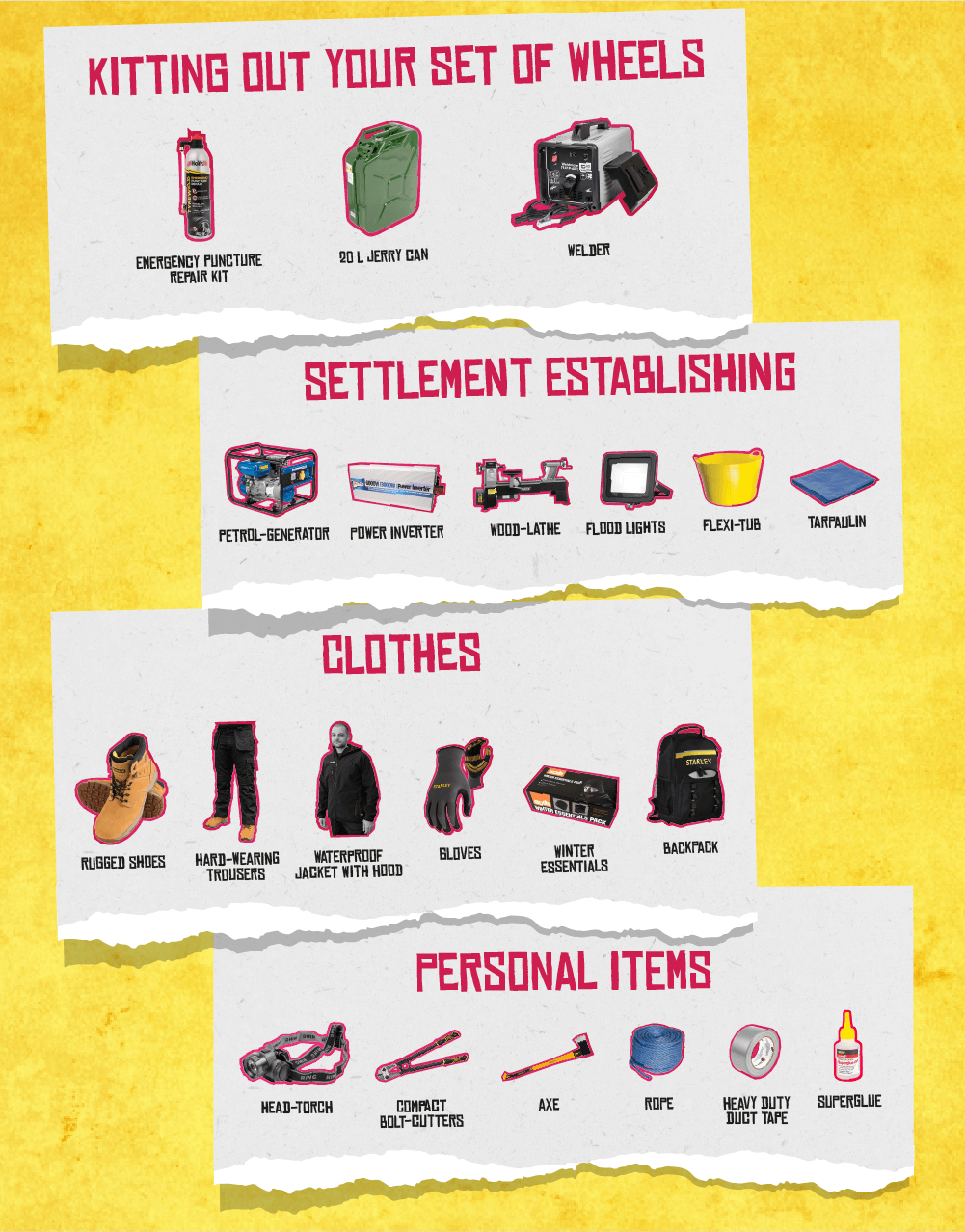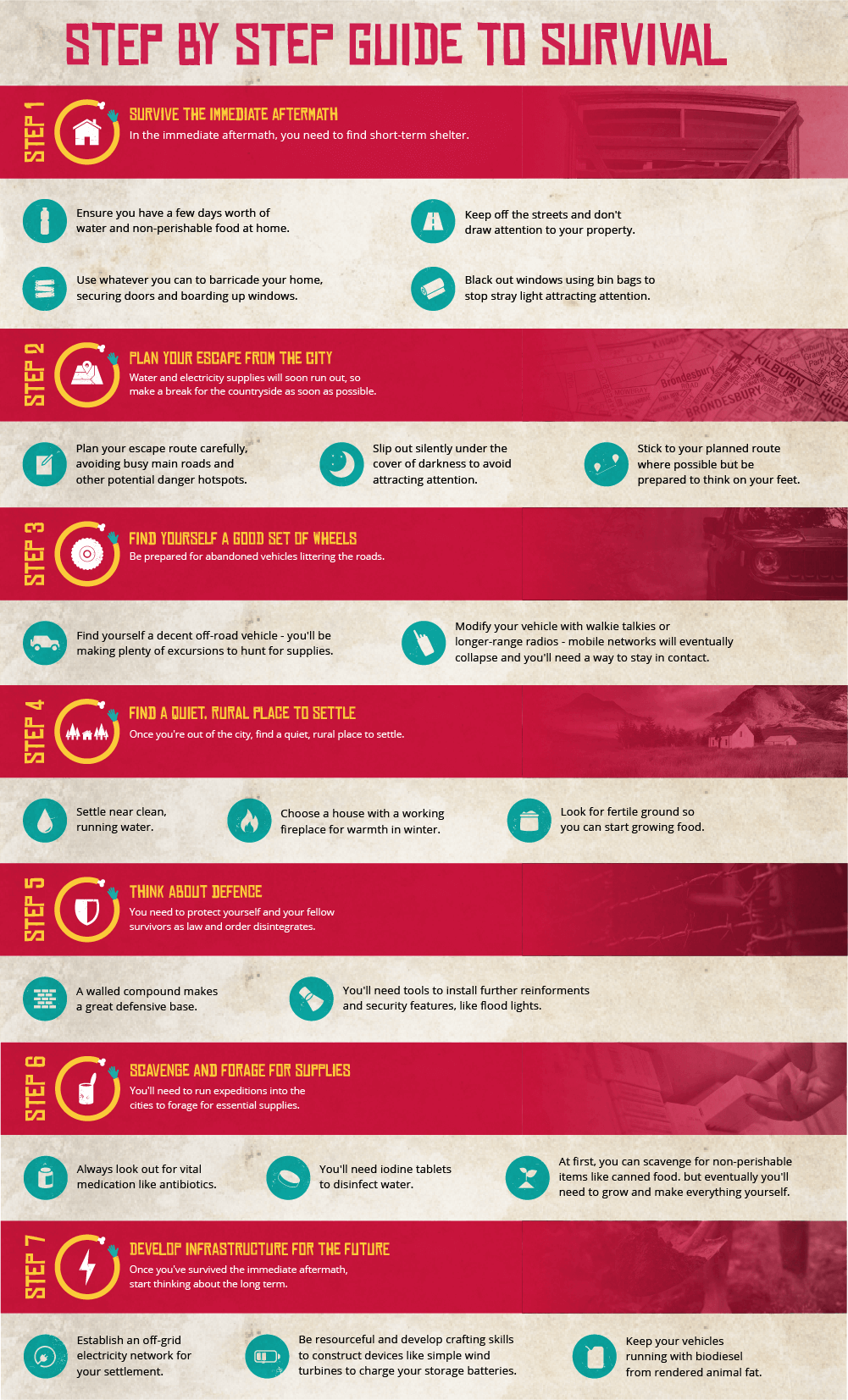Between series like The Walking Dead and films like Shaun of the Dead, we’ve all imagined how we might go about trying to survive a zombie apocalypse at one point in our lives. Now, Toolstation has teamed up with Lewis Dartnell, author of “The Knowledge: How to Rebuild our World after an Apocalypse” to tell us once and for all how to make it out of an apocalypse alive.
In this survival guide, Dartnell talks us through the equipment you’ll need, the survival steps you should take and the people you’ll want around you as you fight to stay alive. Follow this guide and you should have the best possible chance of surviving a real-life zombie attack.
The Apocalypse Checklist
First things first, you need to assemble your tools. Life’s about to get tough, so your clothing needs to be warm, hardwearing and protective.

Clothes
In a post-apocalyptic world, you’re not going to be relaxing around in central-heated buildings any more. You need workwear that’s hardwearing and able to protect you from the elements.
- Safety shoes. When you’re on your feet all day, you want shoes that are not just hardy, but comfortable too. You also need to ensure you won’t slip and break your ankle in a world without hospitals, and are quick on your feet when you really need to get a move on!
- Hardwearing work trousers.
- A waterproof hooded jacket – also dark coloured clothing for hiding in the shadows when you’re mobile at night.
- Work gloves – for extra grip when you really need it.
- Winter essentials – fleece beanie and neck warmer.
- A tool backpack – keep your essential kit with you at all times, and some spare carrying capacity when you’re out scavenging for supplies.
Personal Items
You’ll also want to keep personal items like a head torch and versatile supplies like duct tape close at hand.
- A head torch for hands-free exploring of the dark interiors of abandoned buildings for supplies.
- Compact bolt cutters for gaining access to abandoned buildings to scavenge for supplies.
- An axe. A useful tool for gaining access to abandoned buildings when you’re foraging for key supplies. You’ll also be using firewood an awful lot more now for cooking and keeping yourself warm. Keep your trusty axe close to hand!
- Polypropylene rope has a thousand and one uses. Keep a good length with you in case you ever find yourself trapped up high.
- Heavy-duty duct tape – still unbeatable for quick repairs and bodges to get you through to the next day.
- Superglue – useful for repairing a broken vase, but could even save your life in a post-apocalyptic world. Superglue can be used in emergencies to quickly close the lips of a wound before infection sets in.
Kitting Out Your Survival Set Of Wheels
Next, you need to kit out your apocalypse survival vehicle: a puncture repair kit, jerry can and welder should be top of your checklist. Finish off by packing a few essentials to set up camp in your new settlement. Dartnell suggests that items like a generator, tarpaulin and flood lights will make all the difference.
- An emergency puncture repair kit for getting out of a tight spot quickly.
- A 20 litre jerry can – fill a couple of these to ensure you’re never caught short of fuel.
- A welder for modifying your survival jeep or truck.
Establishing Your Own Settlement
A portable generator will be enormously useful in the early days after the grid goes down for providing your own power. But generators are noisy and might attract unwanted attention, and they will also guzzle through what fuel you’re able to scavenge that you might need to keep for the vehicles.
So for longer-term sustainability of your settlement, you’re going to need to generate your own renewable electricity. Scavenge for thin, sheet metal and use your tools to craft it into the blades of a wind turbine. You’ll also find the chains and gears from scavenged bicycles useful here. The key component you need to convert the rotating power of your wind turbines into electricity is an alternator scavenged from under the bonnet of an abandoned car. Use this to recharge a bank of scavenged car batteries and you’ve got the makings of your own off-grid electrical network.
To run appliances off your bank of rechargeable 12V DC car batteries (i.e converting 12V DC battery output to 230V AC electricity like the Mains) you’ll need a power inverter.
A properly equipped workshop will also be essential for maintaining and repairing everything for your community of survivors.
High-efficiency LED flood lights will help secure the perimeter of your base.
And even simple items will help you survive, like a large flexible bucket and sheets of tarpaulin for collecting rainwater. Rainwater has been effectively distilled, and so is always safer to drink from than rivers or other ground water sources.
The Step-by-Step Guide to Survival
Once you’ve got your kit sorted, it’s time to devise a survival plan. Dartnell has designed a seven-step plan which takes you from the initial aftermath through to building infrastructure geared towards thriving long-term. From planning an escape route and modifying your vehicle to protecting your settlement and foraging for the essentials, Dartnell has thought of everything.

The Survival Team
Finally, Dartnell profiles some of the people you want in your survival team. As we know, teamwork makes the dream work– and never has that been more true than during an apocalypse. From obvious professions like doctors and nurses to people you might not have thought of such as electricians and metal-workers with crucial skills, everyone plays an important role as you face an imminent zombie attack!

To find out the science of surviving an apocalypse and how to reboot civilisation for yourself, read “The Knowledge: How To Rebuild Our World After An Apocalypse”. And to get hold of everything else you might need, head to Toolstation.

